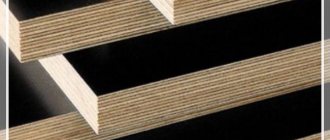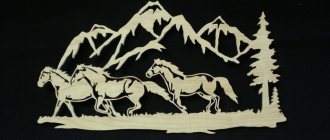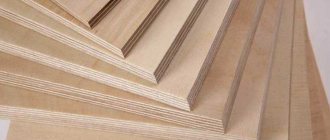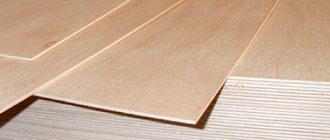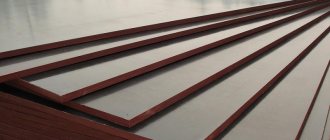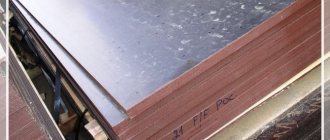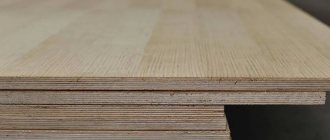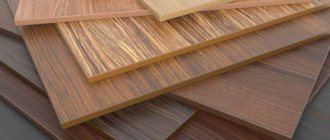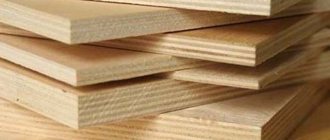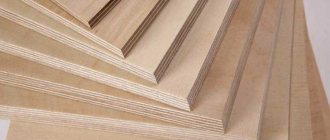Articles
All photos from the article
For many years, plywood has remained one of the most common and sought-after building materials. This is largely due to the large assortment of its types, and all existing brands of plywood differ in their specifics and characteristics. Next, we will get acquainted with the existing types of plywood and their features, which will allow us to choose the right material for each type of work.
Example of plywood marking
General information
As you know, plywood is a multi-layer board made of wood veneer. Many people believe that the material differs only in the quality and type of wood from which the veneer is made.
In reality, there are much more differences. In particular, an important point is the type of bonding component that is used to glue the veneer.
This determines characteristics such as:
- moisture resistance and weather resistance;
- environmental friendliness;
- weight;
- strength and durability;
- material price.
Of course, the marking carries information not only about the type of adhesive, but also the type of material, the type of processing or its absence, etc. Therefore, below we will take a closer look at all the nuances of the marking.
FK grade plywood sheets
Features of each type of plywood
Elite plywood E (A) is not characterized by large quantities of visible flaws and defects. Plywood sheets of this grade are usually purchased to order, have good surface smoothness, and are characterized by ideal dimensions. The material has an attractive appearance of natural wood and does not require any additional processing, except perhaps varnishing. Elite plywood is usually used for decorating exclusive interiors and assembling exhibition furniture. The high strength and moisture resistance of E plywood makes it possible to purchase it for the exterior finishing and interior lining of expensive boats.
On the surface of Grade I (AB) plywood, small amounts of cracks, wormholes, intergrown knots, or even knot holes may be observed. Therefore, this material is of lower quality than elite material, but has excellent strength properties, wear resistance and durability. Aesthetically pleasing plywood sheets are intended for finishing work outdoors, design cladding of premises and for creating furniture.
Grade II plywood (B) is characterized by areas with uneven veneer color and the presence of repair inserts and small cracks on the surface. Products of this type are “counterfeited” more often than others, since it is not difficult for would-be manufacturers to comply with the provisions of regulatory documents regarding the appearance of veneer. But they neglect the technology of assembling veneer layers and drying rules. Original grade B products are strong, resilient and retain their shape well. It is widely used for covering interior partitions and assembling various types of floors.
Plywood grade III (BB) are essentially grade II products that did not pass due to visible defects and non-compliance with other characteristics. Scratches, torn fibers, inserts and small glue leaks are acceptable for this material. According to GOST, the presence of swelling and signs of delamination are not allowed here. It is often used in construction to create load-bearing foundations and rough cladding. This plywood is useful for lining car bodies, making boxes, pallets and other products. Before use, grade III plywood is usually treated with impregnation or paint, which increases its resistance to moisture and improves the appearance of the material.
Appearance of different types of plywood
Grade IV (C) plywood may have many defects on the back or front side. Despite these disadvantages, the material is popular in auxiliary and rough construction work. It is widely used for the production of continuous roof sheathing, formwork for casting concrete, for leveling ceiling and floor surfaces, cladding the facades of outbuildings, etc. The low price of grade IV plywood makes it irreplaceable.
Material grades
Since the main difference between the boards is the type of binding component, before purchasing them, first of all, you need to study the description of plywood brands. Below are their main features:
| Brand | Description |
| FBK | Bakelite varnish is used as a binding component, which is resistant to moisture, temperature changes and other atmospheric influences. As a result, this plywood can be used for exterior use in any climatic conditions. In addition, it is widely used for arranging formwork. FB plywood is also excellent for building boats, and the sheets are not afraid even of direct exposure to sea water. |
| FBS | The veneer of this plywood is treated with alcohol-soluble bakelite glue. Thanks to this, bakelized plywood of the FBS brand is the most resistant to moisture, all kinds of aggressive environments, etc. In addition, the following properties can be distinguished:
It must be said that this brand is also called aviation, since it was used for some time in the aircraft industry. In addition, it is widely used in shipbuilding. But FBS sheets are not used in construction due to their high cost. |
| BV | In the production of this material, bakelite compounds are also used, however, they are water-soluble. As a result, the panels are highly durable, but do not withstand moisture. |
| FC | Before pressing, the veneer is treated with urea compounds. It should be noted that FC is one of the most popular brands, which is widely used in construction and furniture production, which is due to its low cost and good strength. In addition, the advantage of the material is environmental friendliness. Water resistance can be characterized as relative, so the slabs are unsuitable for outdoor use. |
| FBA | Natural albumin-casein adhesives are used for gluing veneer. Thanks to this, this brand is the most environmentally friendly, but at the same time it is completely resistant to moisture. |
| FSF | Phenol-formaldehyde resins are used for gluing veneer. FSF brand plywood has high characteristics of strength, wear resistance and moisture resistance. However, its environmental friendliness leaves much to be desired, so the material is recommended for outdoor use. |
FBS grade plywood sheets
Advice! You can increase the moisture resistance of plywood yourself. For example, if FC brand sheets are impregnated with PVA, they will be able to withstand prolonged exposure to moisture.
Thus, in terms of the combination of price and quality, in most cases the best option is FK plywood. However, if we are talking about outdoor use, it is necessary to use moisture-resistant boards.
Marking of moisture-resistant plywood is, as we found out:
- FBK;
- FBS;
- FSF.
The choice of brand, accordingly, depends on the area of application of the material.
Construction plywood - grading and marking of sheets
In both construction and carpentry, plywood is a very popular material. There are many varieties of plywood boards, and the quality, service life and functionality of the finished product will depend on whether the choice is made correctly.
When determining the suitability of plywood for a particular task, you should first of all pay attention to the technical characteristics and nuances of marking, such as grade, level of moisture resistance, type of treated surface, sheet thickness, etc. Please note that the markings on plywood differ between domestic and imported manufacturers. To choose plywood for your goals and objectives, you need to know what the markings on a plywood sheet mean.
All plywood is different - not only in thickness
Labeling nuances
In addition to the brand, as mentioned above, the marking also contains other information. Therefore, further we will familiarize ourselves with all the symbols that can be found on sheets of plywood.
Example of the surface of different types of plywood
Grade
The marking of plywood must contain the designation of the grade, which determines its quality. According to existing GOSTs, plywood boards exist in the following grades:
| Variety | Description |
| E | Eliminates any defects on the surface of the sheet. |
| I | Small knots and cracks no longer than 20 mm are allowed; |
| II | It is characterized by the presence of knots (up to 10 knots with a diameter of up to 25 mm per square meter), insertion of veneer repair strips and a small number of wormholes are also allowed. |
| III | This grade allows the presence of an unlimited number of fused knots, as well as a small number of holes left from their loss. In addition, up to ten wormholes may be present per square meter of leaf. |
| IV | On slabs of the lowest grade, an unlimited number of wormholes with a diameter of up to 40 mm, as well as knots and holes formed as a result of their loss, are allowed. However, the veneer should not delaminate. |
Surface of elite grade E plywood
It should be noted that there are different grading systems. Often, Roman numerals are replaced with Latin letters “A”, “B” and “C”. Moreover, the letters can be combined, which means a different number of defects.
Of course, it is not difficult to guess that, for example, the technical characteristics of plywood grade FK grade VVS correspond to the lowest category. But, in some cases, it is better to ask the seller what grade the material belongs to in accordance with GOST.
Note! If the grade of material is indicated through a fraction, for example, I/II, this means that the front side corresponds to the first grade, and the back to the second.
Laminated plywood
Processing type
Another important difference between plywood is the type of treatment or lack thereof.
Depending on this, the material is divided into the following types:
- NS (unpolished veneer) - as a rule, used for rough work. True, if necessary, the surface can be sanded with your own hands and save money this way;
- Ш2 – the sheet is sanded on both sides;
- Ш1 – processing is performed only on the front side;
- FOF - the surface of the plywood is laminated, which gives it not only an attractive appearance, but also makes the material more moisture resistant;
- DF-1 – sheets are lined with a film based on melamine-formaldehyde resins;
- DF-3 - a feature of the material is increased water resistance, as well as finishing on both sides with special decorative paper. The lining also contains melamine-formaldehyde resins.
Paper decorated plywood
Wood type
Depending on the type of wood from which the veneer is made, the sheets are divided into two types:
- E – plywood is made of softwood. This material is relatively soft, but at the same time resistant to rotting;
- Ex – hardwoods were used to make veneer. As a rule, birch is used for these purposes. It is more susceptible to rotting, but it is hard and durable.
In the photo - sheets of birch plywood
Emission classes
Emission classes indicate the formaldehyde content of dry sheets.
Depending on this parameter, plywood is divided into the following classes:
- E1 – contains less than 10 mg of formaldehyde per 100 g of material;
- E2 – contains 10-30 mg of formaldehyde;
- E3 – the content of this substance ranges from 30 to 60 mg inclusive.
What does the grade of plywood mean?
According to GOST 3916.1-96, plywood is divided into 5 grades. This is an elite type of “layered wood” (E) and grades, which are designated by numbers from I to IV. You can find designations according to outdated GOST - A, B, AB, BB, C. There are also double digital designations for plywood grades. The fact is that you can buy plywood in Moscow with two surfaces of different quality, which, according to external features, will belong to different grades (2/3, 3/4). By the way, the higher quality side of the slab is considered to be the front side.
Explanation of markings
Plywood markings are applied on its back side.
In this case, the information is arranged in the following sequence:
- grade of material
- type of surface treatment;
- sheet dimensions in millimeters;
- type of material;
- emission class.
Having familiarized yourself with all types of material and their designations, deciphering the plywood markings will not cause any difficulties. For example, on the sheets you can find the following designation - FK.NSH.1525*1525*10.II/II.E1.
If this marking is applied, the plywood in front of you is unsanded and intended for interior work. Its thickness is 10 mm, and the dimensions of the plate are 1525 * 1525 mm.
In this case, the sheet belongs to the second quality grade and contains no more than 10 mg of formaldehyde per 100 g. Also at the end of the marking the GOST number according to which the material was marked can be applied.
Here, in fact, are all the instructions for deciphering the markings.
Criteria for choosing a plywood brand
Chinese manufacturers most often neglect the quality of plywood sheets in their work. However, their products have a low cost, but one must remember that when purchasing such material, the buyer will face numerous problems in the future. Another problem with such production is that unscrupulous manufacturers use soft poplar veneer instead of high-quality raw materials. Often in construction markets you can find options with numerous defects that are not typical even for the lowest quality plywood sheet. However, despite all this, the biggest problem is that the production of this building material uses impregnating and adhesive compounds that negatively affect human health.
In order to purchase high-quality plywood intended for specific jobs, the buyer must study all available types and brands. Manufacturers who take their work responsibly apply certain markings to each sheet. If you know how they are deciphered, you can choose a quality product, one that will be needed for certain processes. You can get the necessary information about a specific material from a store salesperson, but it’s still better to know everything yourself and not rely on someone else’s opinion. To select a quality product, a description of each brand or variety is provided.
Conclusion
As we have found out, there are many different characteristics and properties of plywood. Of course, you don't have to remember all of them. To make a choice, in most cases it is enough to know the main ones, such as brand, type of material and type of surface treatment.
The video in this article contains additional information on the topic discussed. If you have any questions while reading the material, you can leave them in the comments, and we will be happy to answer them.
Which is better OSB or plywood?
Strand board is gradually replacing plywood. Although OSB is generally thinner than plywood, the former is considered to be stronger.
The table shows the parameters that unite and separate them:
| Plywood | OSB |
| From 3 to 10 layers pressed | 4 layers connected by hot pressing |
| The base is veneer from any wood | Only coniferous tree shavings are used |
| Usually the sheets are large | The sheets are medium in size |
| The highest class is not afraid of moisture and is as durable as possible | High-class sheets have increased wear resistance and are not afraid of moisture |
Both materials can be used in the production of furniture, as well as for laying subfloors. At the same time, plywood in some cases can also serve as a top floor covering (for example, veneered or bakelite varieties). It is impossible to compare these materials and find the best one among them for the reason that OSB can be considered a modernized copy of plywood.
No matter what derivatives of particle boards appear, a person will not be able to completely do without plywood. This board is still indispensable in many stages of construction, and for boats, yachts, airplanes and trains, no analogues have yet been invented that would be at least somehow better than plywood.
Strength
This parameter determines how well the building material can withstand mechanical loads. The strength characteristics of wood boards include the flexural strength along the main axis (the long side of the board), the tensile strength, and the flexural modulus along the main axis. The unit of measurement is megapascal (MPa) or newton per square millimeter (N/mm2).
Standard flexural strength values
For OSB:
- OSB-1 – 16-20 MPa;
- OSB-2 – 18-22 MPa;
- OSB-3 – 18-22 MPa;
- OSB-4 – 26-30 MPa.
For fiberboard:
- soft –0.4-1.8 MPa;
- semi-solid – 15 MPa;
- hard – 40 MPa;
- superhard – 47 MPa.
For plywood:
- FC – 35 MPa (coniferous), 55 MPa (birch);
- FSF – 40 MPa (coniferous), 60 MPa (birch);
- FBS – 78.5 MPa;
- FOF – 60 MPa.
Standard tensile strength values
For OSB:
- OSB-1 – 0.26-0.3 MPa;
- OSB-2 – 0.3-0.34 MPa;
- OSB-3 – 0.3-0.34 MPa;
- OSB-4 – 0.4-0.5 MPa.
For fiberboard:
- hard – 0.3 MP;
- superhard – 0.32 MPa.
For plywood:
- FC – 30 MPa (coniferous and birch);
- FSF – 40 MPa (coniferous and birch);
- FBS – 59 MPa;
- FOF – 30 MPa.
Standard values for flexural modulus
For OSB:
- OSB-1 – 2500 MPa;
- OSB-2 – 3500 MPa;
- OSB-3 – 3500 MPa;
- OSB-4 – 4800 MPa.
For fiberboard:
- soft – 170-880 MPa;
- hard – 2800-5600 MPa;
- superhard – 5600-7000 MPa.
For plywood:
- FC – 5000 MPa (birch);
- FSF – 6000 MPa (birch);
- FOF – 6000 MPa.
Other options
Humidity means the moisture content in the slab. Measured as a percentage. The higher the humidity, the higher the likelihood of mold and warping due to high temperature and low humidity. Wood boards that are too dry have low strength and are difficult to process. In OSB the humidity is 4-12%, in fiberboard - 4-10% (dry method), 60-70% (wet method), in plywood (FC, FSF) - 5-10%.
Fire resistance – characterizes the fire safety of a building material. OSB has a fire safety class of B-s2, d0. Fire-resistant plywood is divided into several classes: G1 (low-flammable), TG (low-flammable), B2 (moderately flammable), T2 (moderately hazardous in toxicity), D2 (with a smoke generation coefficient).
Thermal conductivity - describes the thermal insulation properties of wood board, which is important for interior work. The unit of measurement is watt per meter kelvin (W/m*K).
Standard thermal conductivity parameters:
- OSB – 0.14 W/m*K (OSB-3);
- Fiberboard – 0.046-0.093 W/m*K;
- plywood – 0.09-0.25 W/m*K.
Sound insulation - allows you to evaluate the ability of a material to reduce the level of noise that enters the room from the external environment. Determined by the density and thickness of the wood board. Sound insulation is measured in decibels (dB).
Standard sound insulation parameters:
- OSB –29 dB;
- soft fiberboard –19-35 dB;
- plywood – 20-25.3 dB.
Sound absorption coefficient - shows how much the energy of a reflected sound wave decreases upon contact with a surface, for example, a partition. The value of the coefficient varies from 0 to 1 (as 1 approaches, sound absorption also increases).
Standard sound absorption coefficients:
- OSB – 0.35;
- soft fiberboard – up to 0.8;
- plywood – 0.3.
Formaldehyde emission class - gives an idea of the toxicity level of the wood board.
Formaldehyde emission classes:
- E0 – up to 6.5 mg/100 g of dry material (for interior work);
- E1 – up to 10 mg/100 g of dry material (for interior work);
- E2 – 10-20 mg/100 g of dry material (for outdoor use);
- E3 – up to 30 mg/100 g of dry matter (for outdoor use).
Classification of plywood by material:
- Coniferous plywood.
In the production of coniferous plywood, softwood veneer is used (pine, larch, spruce, fir). The advantages of this plywood include good resistance to fungus and moisture rot. This is explained by the presence of natural resin impregnation of softwood, in addition to the phenol-formaldehyde impregnation used in the manufacture of plywood. As a rule, the weight of coniferous plywood is 25% less than birch plywood.
- Birch plywood (hardwood).
Birch plywood is made from birch veneer. The advantages of this plywood include better strength characteristics compared to coniferous plywood. At the same time, its cost is more expensive than coniferous plywood, due to more expensive raw materials.
Surface
OSB and plywood
Unsanded - widely used in construction, for example, when finishing floors and roofs or to create formwork. Unsanded slabs are most common.
Polished – characterized by smoothness, absence of defects and contamination. A similar option is used for making furniture. In construction and finishing works, polished slabs are in demand when there are strict thickness requirements.
OSB-4 is also found with a varnished and laminated surface. Such materials are distinguished by their impressive appearance and increased resistance to wear and moisture.
Fiberboard
Depending on the nature of processing, hard fiberboard is available in several grades:
- T – with untreated front surface;
- T-P – with painted front surface;
- TS – with a front surface made of fine chips;
- T-SP – with a painted front surface made from fine chips;
- Т-В – increased moisture resistance with untreated front surface;
- T-SV – increased moisture resistance with a painted front surface.
Super-hard fiberboard made from fine chips with a treated front surface is marked ST-S.
